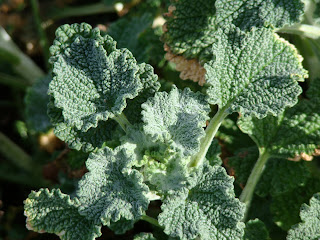Epazote (?) picture taken at Daley Ranch, Escondido
If you were ever interested in spices for cooking, no doubt you came across epazote, especially if you live in an area where Mexican cuisine is popular. You can buy this plants in ethnic Mexican stores. It is rather bland in taste and have a faint neutral flavour. It is most commonly used in bean dishes.
So what's the mystery? Well, if you ever tried to find more information about epazote on internet you would come across descriptions that are quite different from the one above. The plant have small leaves with serrated edges. However, most of the descriptions specifically mention unpleasant or at least strong odour. In fact, the name epazote means something like the smell of skunk (I could not verify this information because, as usual, as soon as I checked it out again it disappeared from internet). The name is derived from Nahuatl word epazotl.
In fact I myself found the plant that looks like epazote in the wilderness parts near Escondido, CA. It does indeed have an unpleasant smell. It's bad enough not to use for cooking.
Anyway how can one plant be described so differently. Well... here is my theory.
There are, in fact, two similar looking plants, both referred to as epazote. One is what can be bought in Mexican stores, another one is the stinky plant. They do indeed look very much alike: the leaves are of similar size and shape. The one I found in the wild also had tiny red flowers.
I still don't know for sure if it is epazote or not in the above pictures but it sure looks like it. We'll consider it epazote until proved otherwise.
Update on April 2011. Here is the picture of real epazote taken in Botanical Garden in Tucson. This plant has a nice smell. As you can see, the plant is different from the one above.
Epazote from Tucson Botanical Gardens
So they are indeed two different plant and it's hard to tell the difference unless you compare them side by side. The plant on the first picture has more serrated leaves and unpleasant smell. The second one has a nice smell and the edges are less serrated.
Update April, 2012. I identified the plant in the first picture! It is called figwort and it grows pretty much everywhere. It has medicinal properties but it is not edible.
The mystery is solved.


































